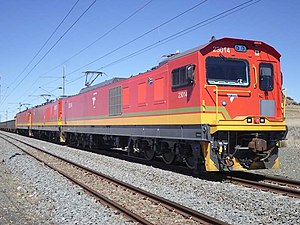TFR class 23E
| TFR class 23E | |
|---|---|
|
Three class 23E locomotives in front of a manganese ore train
|
|
| Numbering: | 23 001 - 23 240 |
| Number: | 240 |
| Manufacturer: | Bombardier Transportation |
| Year of construction (s): | 2017– |
| Axis formula : | Co'Co ' |
| Gauge : | 1067 mm ( cape track ) |
| Height: | 4.138 m |
| Width: | 2.9 m |
| Bogie axle base: | 3.7 m |
| Service mass: | 132 t |
| Wheel set mass : | 22 t |
| Top speed: | 100 km / h |
| Continuous output : | 3.8 MW |
| Power system : | 25 kV 50 Hz ~ 3 kV = |
| Number of traction motors: | 6th |
| Drive: | Pawbearing drive |
The Transnet Freight Rail Class 23E is from 2018, commissioned in six-axis dual-system - electric locomotive for freight of Transnet Freight Rail (TFR) in South Africa . The locomotive was designed by Bombardier Transportation and is designed to operate on 3 kV direct current and 25 kV 50 Hz alternating current.
history
In March 2014, Bombardier Transportation and TFR signed a contract for the delivery of 240 locomotives to be used in manganese ore transport and in front of general freight trains.
The contract value of the contract is the equivalent of 933 million euros . More than 60% of this is spent on materials and services in South Africa. With a technology transfer, Bombardier created 300 jobs in South Africa, which supports the government's Broad-Based Black Economic Empowerment (B-BBEE).
The locomotives are entirely built in South Africa. Ninety different South African suppliers build parts for the locomotives according to Bombardier plans. The most important are DCD in Boksburg for the car body, the Bombardier plant in Isando for the equipment scaffolding and converters , and IEC Holden for the traction motors . Final assembly is carried out in a Transnet maintenance facility in Durban. The same plant also builds the locomotive bogies .
The first locomotive was handed over to the customer by TFR in December 2017. Commercial operation began in 2018. The locomotives run exclusively on the Mangangerzbahn from Hotazel via Postmasburg and Kimberley to Port Elizabeth .
technology
The locomotives look very similar to the class 22E locomotives. The welded car body is a self-supporting structure. The two three-axle bogies with tatzlager drives are similar to those of the MTAB IORE from LKAB Malmtrafik . Two derailment bars on the head girders of the bogies prevent the locomotive from tipping over in the event of derailment or from damaging the axle drives.
Arrangement of the devices
The 23E locomotives only have a driver's cab at one end . In the engine room , the devices are arranged to the left and right of a central aisle. From front to back the arrangement is as follows:
Left side
|
right side
|
Pantograph
The two single-arm pantographs on the roof are each arranged above the pivot points of the bogies. Both pantographs can be used for both electricity systems. The arrangement of both pantographs with the knee pointing back is unusual.
Two-system operation
The main circuit is automatically configured for direct current or alternating current operation depending on the voltage applied to the pantographs . The phase and system change protective routes are signaled to the vehicle by track magnets. They activate reed switches attached to the ends of the locomotive , which automatically switch off the pulling force, open the main switch and close again after the protective route. The tractive force is then built up again automatically.
In direct current operation, the contact line voltage is fed directly into the intermediate circuit via a choke ; in alternating current operation, the contact line voltage is reduced by the main transformer and fed to the intermediate circuit by six four-quadrant controllers. Each traction motor has its own inverter , which is supplied with energy from the intermediate circuit.
Individual evidence
- ↑ a b c Bombardier and Transnet Freight Rail Celebrate Handover of First TRAXX Locomotive Africa at Ceremony in Durban. Bombardier, December 8, 2018 (English).
